Lea Wait's Blog, page 301
January 12, 2015
Iguana Do Some Writing?
 Hi. Barb here. In a great counterpoint to Lea Wait’s post about Maine winters yesterday, I thought I’d post about my new writing companions in Key West, Florida.
Hi. Barb here. In a great counterpoint to Lea Wait’s post about Maine winters yesterday, I thought I’d post about my new writing companions in Key West, Florida.
My husband and I are here for two months, and due to, umm, a little too much fun over the holidays, I am on a strict writing regime. I’m in first draft mode, which I have learned I must endure to get to the part I love, love, revisions. I’ve told everyone I know that if I write 1000 words everyday (including weekends) and get in the pool everyday, it’s a good day. What about the hundreds of other temptations Key West has to offer? If I finish those two tasks early enough, fine, I can play, but if not, too bad.
 Lately, as I write in the late afternoons, this guy has been joining me. He’s a green iguana. They came to Florida as pets and now have overrun the place. Apparently they reproduce like crazy, up to 50 eggs in one nest. They’re territorial and not worth trapping, because once one is gone a new one will soon move in to replace him.
Lately, as I write in the late afternoons, this guy has been joining me. He’s a green iguana. They came to Florida as pets and now have overrun the place. Apparently they reproduce like crazy, up to 50 eggs in one nest. They’re territorial and not worth trapping, because once one is gone a new one will soon move in to replace him.
 They can grow up to five or six feet, and I did see one in the vacant lot behind us who was as big as a dog. They’re herbivores and won’t hurt you unless they’re cornered. But I have to admit, I’m creeped out by the way they look. It’s like Jurassic Park has opened a petting zoo in our yard. Don’t worry! I won’t be petting them. I’ve seen how the movie turned out.
They can grow up to five or six feet, and I did see one in the vacant lot behind us who was as big as a dog. They’re herbivores and won’t hurt you unless they’re cornered. But I have to admit, I’m creeped out by the way they look. It’s like Jurassic Park has opened a petting zoo in our yard. Don’t worry! I won’t be petting them. I’ve seen how the movie turned out.
The first time I saw one, it was our backyard one, not this front yard guy. I was in the pool and heard a rustling overhead and I looked up into the palm trees and there he was, eating a tasty lunch of new palm leaves. He seemed supremely undisturbed by my presence, which is more than I can say for myself. I jumped out of the pool I was cowering beside the house when my husband arrived home. He pointed out that given the spray bottle of “Iguana Be Gone” on the deck, I shouldn’t have been quite so surprised.

The pool guy
The iguana proceeded to stroll along the top of our fence, casual as you please. Iguana Be Gone, by the way, is mostly cinnamon and garlic and impresses iguanas not one whit.
The creepiest thing about iguanas, aside from their obviously creepy looks, is that though they have evolved to climb trees quite efficiently, they cannot climb down. Instead, they have the ability to fall up to forty feet without injuring themselves. When we used to come to Key West with my mother, we stayed in a multi-story resort. When a big iguana came hurtling off the roof onto the cement pool deck–THWUMP!– it freaked me out every time.
 Apparently they can be quite the pests, and love to poop in your pool. We haven’t had this problem yet, and I’m hoping if we continue with our current live and let live policy, things won’t escalate. In the meantime, I’m getting used to seeing my writing companion hanging around outside my window in the afternoons.
Apparently they can be quite the pests, and love to poop in your pool. We haven’t had this problem yet, and I’m hoping if we continue with our current live and let live policy, things won’t escalate. In the meantime, I’m getting used to seeing my writing companion hanging around outside my window in the afternoons.
January 11, 2015
Maine Winters
Lea Wait, here – a nd, yes, I’m in Maine.
nd, yes, I’m in Maine.
If you live in Maine, people from away often ask: Do you stay there all year?
If the answer is “yes,” then you’ll often see a shaking head and the comment, ” How do you cope with the snow and cold?”
The answer is: Snow and cold aren’t problems. Oh, I’ll admit that, living in a house built in 1774, I do sometimes wonder how people kept warm here two hundred years ago. But over the years central heating and a woodstove and electricity and indoor plumbing (water from our own well) have made a major difference in the house’s temperature. And that doesn’t even begin to mention attic and cellar insulation and storm windows. (And a friend with a plow and, in real emergencies, a generator that keeps the water and heat on, if little else.)
But here’s the real secret: Maine, at least near the coast, where I live, doesn’t get THAT cold. Sure … in the 16 winters I’ve spent here we have had some sub-zero days. In fact, in the past week …. But not that many. And snow? Some winters it’s on the ground for months; other years there’s very little. In the past couple of years (really, it’s true!) New Jersey and Connecticut have gotten more snow than we have on the coast of Maine. And Maine copes very well with the amount it gets. Schools and businesses don’t often close, mail is delivered, and rarely is there a line at the supermarket for bread and milk and batteries.

 And, although I certainly love Maine in the warmer months (how could anyone not?) there are special joys in the wintertime.
And, although I certainly love Maine in the warmer months (how could anyone not?) there are special joys in the wintertime.
When the deciduous trees (no, not all Maine’s trees are firs and pines) lose their leaves, the views of the water are even more breathtaking.
The crackling ice on the edge of tidal rivers is beautiful.
Many Maine organizations, from churches to schools to libraries to Ys and book groups, schedule most of their activities in the winter. In summer, most Mainers are focused on visitors. Winters are for the locals.
Winters are the time for writers to write, artists to paint, craftsmen and women to create. Focus comes more easily; there are fewer distractions than in other seasons.
 Winter is a time to catch up with all the movies you didn’t have time to see last summer; the books you’ve been wanting to read; the recipes you’ve clipped but haven’t forgotten. It’s a time for neighbors to gather together, relax, and get caught up.
Winter is a time to catch up with all the movies you didn’t have time to see last summer; the books you’ve been wanting to read; the recipes you’ve clipped but haven’t forgotten. It’s a time for neighbors to gather together, relax, and get caught up.
I’ll admit it’s a dark season. In December and January the sun sets before 4:30 in the afternoon. But it’s also a time for the warmth of lit windows and fireplaces. A time to assess the world, and our place in it. A time to study garden catalogs and boating magazines; to plan trips, or even take them.
Many Mainers who don’t have children in school take their vacations in January, February, or March. Some businesses that have been open 7 days a week for months close then. Those who aren’t snow mobilers or skiiers head south for a week or a month. It’s a quiet time here, and everyone has their own way of enjoying it.
For me, it’s a time to focus on writing. This year I have a manuscript due March 1, and another to start then. For my husband, who’s an artist, it’s a time to work on new canvases that will be ready to hang when galleries open for the (summer) season.
It’s a time to talk and reassess our priorities.
This time of year we wear sweats and sweaters and sometimes long underwear. We feed the birds and admire the wide vistas that are hidden in other seasons. We make bean soup and beef stew and fondue. We enjoy being together.
What season could be better?
January 9, 2015
Weekend Update: January 10-11, 2015
 Next week at Maine Crime Writers there will be posts by Lea Wait (Monday), Barb Ross (Tuesday), Al Lamanda (Wednesday), Jayne Hitchcock (Thursday), and John Clark (Friday).
Next week at Maine Crime Writers there will be posts by Lea Wait (Monday), Barb Ross (Tuesday), Al Lamanda (Wednesday), Jayne Hitchcock (Thursday), and John Clark (Friday).
In the news department, here’s what’s happening with some of us who blog regularly at Maine Crime Writers:
 from Kathy Lynn Emerson: Starting Monday at midnight, I’ll be doing a Goodreads giveaway of three copies of the UK edition of Murder in the Queen’s Wardrobe. The link to enter (although I think you have to join Goodreads to do it) is https://www.goodreads.com/giveaway/show/121317-murder-in-the-queen-s-wardrobe
from Kathy Lynn Emerson: Starting Monday at midnight, I’ll be doing a Goodreads giveaway of three copies of the UK edition of Murder in the Queen’s Wardrobe. The link to enter (although I think you have to join Goodreads to do it) is https://www.goodreads.com/giveaway/show/121317-murder-in-the-queen-s-wardrobe
The giveaway runs from January 12 until midnight January 26. The book will be published in the U.S. in hardcover in March with the Kindle edition to follow. This is the first in a new historical mystery series set in the 1580s. This first one takes place in England and Muscovy (Russia) and involves the protagonist, Mistress Rosamond Jaffrey, in both sleuthing and spying. I’m categorizing it as a “cozy thriller” with a sleuth who has a few personal issues to work out—issues appropriate to the sixteenth-century setting, of course.
In the advance planning department: keep the date April 11th open. The second Maine Crime Wave, sponsored by Maine Writers and Publishers Alliance, will be held on that day in South Portland. The regulars at MaineCrimeWriters.com will be well represented among the panelists and workshop presenters. The incomplete list available at this date includes Kate Flora, Barb Ross, Lea Wait, Kathy Lynn Emerson/Kaitlyn Dunnett, Sarah Graves, Al Lamanda, and alums Gerry Boyle and Paul Doiron.
Lea Wait: Monday night, January 12, I’ll be speaking at the Freeport Community Library in Freeport, Maine at 6:30. And Friday night, January 16, I’ll be joining other authors and illustrators of books for children at Nerdy Authors Night from 6:30-8:30 p.m. at the Falmouth Elementary School. Both events are free and open to the public.
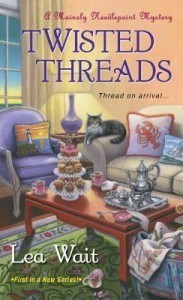 And this week was the debut of my Twisted Threads! To read a short prequel and sign up for a giveaway, click on http://wp.me/p3nHH-5RU
And this week was the debut of my Twisted Threads! To read a short prequel and sign up for a giveaway, click on http://wp.me/p3nHH-5RU
An invitation to readers of this blog: Do you have news relating to Maine, Crime, or Writing? We’d love to hear from you. Just comment below to share. Don’t forget that comments are entered for a chance to win our wonderful basket of books and the very special moose and lobster cookie cutters.
And a reminder: If your library, school, or organization is looking for a speaker, we are often available to talk about the writing process, research, where we get our ideas, and other mysteries of the business. Contact Kate Flora: kateflora@gmail.com
January 8, 2015
First Love
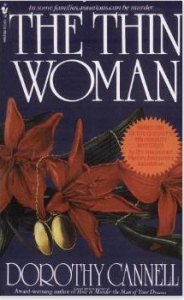 Dorothy Cannell: My first book The Thin Woman was published in 1984. After some serious finger counting (my math level being a first grade C-) I realized that’s thirty years ago. Hard on the heels of that thought came the memory of the wonderfully, magical year I spent writing it. The children would leave for school in the mornings. I’d clear the kitchen table and heft my manual typewriter (purchased second hand by husband for fifty dollars) onto it and give myself three hours in the world of my characters and a house named Merlin’s Court. I knew nothing about publishing, the vagaries of the market, or even that there were such people as literary agents.
Dorothy Cannell: My first book The Thin Woman was published in 1984. After some serious finger counting (my math level being a first grade C-) I realized that’s thirty years ago. Hard on the heels of that thought came the memory of the wonderfully, magical year I spent writing it. The children would leave for school in the mornings. I’d clear the kitchen table and heft my manual typewriter (purchased second hand by husband for fifty dollars) onto it and give myself three hours in the world of my characters and a house named Merlin’s Court. I knew nothing about publishing, the vagaries of the market, or even that there were such people as literary agents.
I had fallen in love with a story about a young woman who’d been given the opportunity to live a fairy story, tinged with the menace of evil that inhabits those of the suitably named brothers Grimm. I did not know I was writing a mystery. I thought of it as a gothic frolic.
Yes, I dreamed of selling what was then called Cobwebs and Candlelight, I fantasized about seeing my name on the cover and imagined the shower of amazed congratulations received. But that was secondary to reveling in tapping out the story Ellie (narrating character) was telling me sentence by sentence, page by page. No pressure to write something as good as or better than had gone before. No deadline. No glimmer that this was the start of my Ellie Haskell series.
When I meet writers aspiring to be published I understand their yearning to have their book accepted and published; and I say, “Treasure this time when it’s just you and your story. It is a time that will never come again. There will be others in the future, perhaps better written, more matured, richer, but the process may not have that sparkling optimism that comes with writing your first love.”
We Are Charlie
Yesterday morning’s news from Paris has rocked me to my core. As I made my morning cup of Irish breakfast tea I heard the report on NPR: twelve people killed in a terror attack at the offices of Charlie Hebdo, a French satirical magazine that has published controversial Muhammad cartoons.

Vicki Doudera here. It’s so horribly wrong on several levels. First – the taking of innocent lives – but second, the taking of those lives because the murderers were offended by free speech. Third – I’m not a scholar of world religions, but I’m pretty sure that Muhammad did not advocate murder as a way to solve problems. (Nor did Jesus, but I realize many wars have been waged on His behalf despite that, too.)
The French are beyond shocked. It’s the worst attack in their country since World War II. Several of those killed were household names, cartoonists who resonated very deeply with French culture. This is a wound – a big one.
I’m remembering my year of living in Paris, slogging up the stairs, fresh baguette in hand, to my little 4th floor apartment in Montmartre. I am heartsick for the city, for the people I remember, for their sense of trust and safety that has been shattered by this vicious act of terrorism.
And I feel a solidarity – not just with the grieving citizens of France, but with artists everywhere. Anyone who dares take up the pen, whether to draw cartoons, shape stories, paint pictures, or express an opinion, is putting themselves, just like those who worked for Charlie Hebdo, in the line of fire. I may write crime stories that seem on the surface to be innocuous, and yet they undoubtedly have the power to offend someone, somewhere. My last book dealt with the growth of a shadowy secret service in Russia. The facts are true, woven into fiction. Could they offend? Could some twisted mind read Deal Killer and want to do me harm?
The answer – for anyone who dares write more than drivel – is yes. We are all Charlie, we are all united, we all must stand up for free speech and against measures that “offend” this or that group. We may not always like what we see or read, but that is the cost of living in a free society, one which allows every voice – no matter how offensive – to be heard.
Vive la liberté. Pick up your pen and write.
January 6, 2015
All it Takes is One Clue
Kaitlyn Dunnett/Kathy Lynn Emerson here. Today I want to tell you a story about solving a real-life historical mystery. There’s no murder. There isn’t even a crime. That doesn’t cut down on the thrill of finding the one clue that leads to more discoveries and, finally, a solution to the puzzle. Where does one find such mysteries? Try climbing your family tree.

my grandfather, Fred Gorton
I’ve been interested in genealogy for a long, long time. My grandfather, who was born in 1878, put together a family history when he was in his eighties and I was still a pre-teen. He wrote to all his relatives to track down names and dates and recorded them meticulously. When he was done, he had a little pamphlet printed to distribute to everyone in the family. Of course, he insisted that it was his great-grandfather who first came to this country back in the 1790s, when it was really a much more distant ancestor back in the 1630s, but aside from that small misconception, he did a pretty good job, especially for a man who only had an 8th grade education.
These days, it is much easier to do genealogical research. Anyone who has ever seen an Ancestry.com commercial or watched Who do you think you are? has some idea of how to go about it and most of the research can be done online. The biggest stumbling block, however, is still the same thing that caused my grandfather to go astray—what someone in the family claimed was true . . . that isn’t.
That’s where the mystery solving comes in.
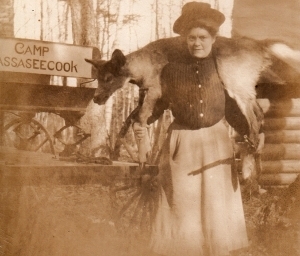
Susanna Hartley, Grandad’s mother
In the pursuit of my hobby, I’ve been climbing both my own family tree and my husband’s. One branch of his family in particular, the Hartleys, took some doing to untangle. It wasn’t that we didn’t have information on them. It was that some of what we had was wrong. Susanna Hartley was my husband’s great-grandmother. Her son, aka Grandad, always boasted that she was one of the “Philadelphia Hartleys,” making it sound as if the family was both wealthy and prominent in that city. Of course, this is the same man who claimed to be a direct descendant of Ralph Waldo Emerson—an out and out fabrication. He knew full well the family had been in Maine since right after the Revolutionary War. Then, too, there is the complication that Ralph Waldo has no descendants.
 When I took my first look at the Hartley connection, twenty or so years ago, I quickly discovered that the Hartleys might have settled in Pennsylvania, near Philadelphia, but they were definitely not part of the upper crust. They worked in the woolen mills there and sometimes traveled to Maine, Massachusetts, and New Hampshire to find similar work. The first of the family to come to the U.S., or so everyone said, was Ellis Hartley, who applied to become a citizen in 1872. On one of his daughters’ death certificates was the information that he had been born in Manchester, England. Extrapolating from census records, this would have been in about 1851.
When I took my first look at the Hartley connection, twenty or so years ago, I quickly discovered that the Hartleys might have settled in Pennsylvania, near Philadelphia, but they were definitely not part of the upper crust. They worked in the woolen mills there and sometimes traveled to Maine, Massachusetts, and New Hampshire to find similar work. The first of the family to come to the U.S., or so everyone said, was Ellis Hartley, who applied to become a citizen in 1872. On one of his daughters’ death certificates was the information that he had been born in Manchester, England. Extrapolating from census records, this would have been in about 1851.
A few years ago, I revisited my research. By then, I had access to Ancestry.com. I was sure that with a name like Ellis Hartley, he wouldn’t be all that hard to find in census records for Lancashire, England. Boy was I wrong. Ellis Hartley isn’t quite as bad as John Smith, but there were four or five of them in the right age range and geographical area. I made my best guess at which one he was, plugged the information into a family tree on the Ancestry.com website, and called it good.
About six months ago, another Ancestry.com subscriber contacted me out of the blue to say she thought our family trees were connected. According to her, Ellis Hartley was the son of John and Susanna Briggs Hartley . . . of Yorkshire. She didn’t have too much information. Her interest was in the Briggs family. But once she provided me with a clue—the fact that Ellis’s mother, uncle, aunt, and a few siblings all came over to the U.S. together—and a few more names, I was off and running. The confusion over what county Ellis came from? It turns out he was born in Lancashire, right on the border with Yorkshire, and the family moved about ten miles into the neighboring county when he was a boy.

painting of the sailing ship Saranak being towed into port by a steamboat
The most exciting discovery was a ship’s manifest for the Saranak for 1866. There was a reason Ellis Hartley hadn’t shown up in earlier searches. His name was spelled “Ellice” in the manifest. Other finds quickly followed—census records, birth records, marriage records—but I wasn’t having any luck figuring out what happened to Ellis’s father. Then it dawned on me that he might have come over earlier, to scout the land, as it were, and there he was. He didn’t arrive in Philadelphia, where the Saranak landed. He came by way of New York, about six months earlier, together with his oldest son and a married daughter.
I won’t go on and on—relating adventures in genealogy can be right up there with showing off baby (or cat) pictures—but if anyone is interested in reading the results of my research into family history, the index to my grandfather’s biography and various family trees I’m working on can be found online at Family History along with an assortment of photos of people and places. The real message here is that if you enjoy solving mysteries as a reader, you might also like to try solving them in your own family, exposing misconceptions, finding clues, and eventually figuring out where the story really began.
January 5, 2015
The Story Behind the Story
 Kate Flora here. It’s January, which is not among my favorite months except in one respect: January as many writers will tell you, is a fabulous writing month. When I have to put on my heaviest coat–the one that makes me feel like a kid in a stiff snowsuit–just to walk to the mailbox, you will not find me complaining when my work requires me to sit for hours at my desk. I am not tempted out into the garden. I certainly won’t swim in the sea. It isn’t a lovely day to take a walk. Lying on the ice in my driveway watching the clouds float by and imagining shapes in them really isn’t on. But sitting for many hours, slaving over a revision? I’m ready to embrace it in January.
Kate Flora here. It’s January, which is not among my favorite months except in one respect: January as many writers will tell you, is a fabulous writing month. When I have to put on my heaviest coat–the one that makes me feel like a kid in a stiff snowsuit–just to walk to the mailbox, you will not find me complaining when my work requires me to sit for hours at my desk. I am not tempted out into the garden. I certainly won’t swim in the sea. It isn’t a lovely day to take a walk. Lying on the ice in my driveway watching the clouds float by and imagining shapes in them really isn’t on. But sitting for many hours, slaving over a revision? I’m ready to embrace it in January.
So let’s talk a little bit about revision. Years ago, when I was a young and inexperienced writer, I hated revision. I did not embrace it. During the ten years I spent in the unpublished writer’s corner, having those awkward conversations at cocktail parties that usually ended with, “Are you published?” and when the answer was no, someone walking away to find a more interesting conversational companion, when I finished a book, I would poke at it a few times, put it away, and start a new one. If someone criticized a story I was writing, I would put it away and start another one. When an editor sent a rejection letter, I would paste it to the bathroom wall and start another book.
But I got over that. I evolved. I stopped being so childish and emotionally tender. I accepted that writers need to learn to deal with criticism. I learned to listen to the comments I was getting, looking for common themes or threads, and then rewrite the books. I stopped sulking when an astute reader said, “Your character is being stupid and Thea wouldn’t do that, she isn’t stupid.” And I started getting published, which meant I had an actual editor who might send me a nine page, single-spaced letter detailing the changes that she wanted, ending with “And pump up the Andre quotient.” Then we would have the discussion, or the argument, over those changes, reach an agreement, and I would make some, not make others, and end up with a better book. Thank you, Claire Eddy at Tor and Leona Nevler at Ballantine, for believing in my books and making me rewrite ’til my eyeballs bled.
Then I started my Joe Burgess series. One January day–yes, January, I decided to pick up on something people kept saying when I did library and bookstore talks. It went something like this: Reader–I’ve always wanted to write a book, and someday, when I have a free weekend, I’m going to write one. I confess to being amazed. It takes me anywhere from six months to several years to write a book, and I was meeting people who could do it in a weekend. Awed, disbelieving, and challenged, I decided to see how fast I could write a book. So I sat down that January and wrote Playing God, my first Joe Burgess police procedural. Four and half crazy months later, during which I wrote about ten hours a day and at the end of which I was so devoid of words I couldn’t write a grocery list, I typed “The End” at the bottom of a 485 page manuscript.
The agent I found to represent it–Joshua Bilmes–was never able to sell it, but he turned out to be the best editor I’ve ever had. He made me get rid of characters and telescope (combine) others. He made me take 100 pages out of the book. He helped me showcase the story and characters and give the book the dark voice and tone it ended up with. He taught me a lot, but the most important things he taught me were what are now my own rules for rewrite. Once the book is done, I make an “after the fact” outline. For each chapter, I describe, in just a few sentences, what happens. Then I ask the all-important questions:
How does this chapter or scene advance the plot?
How does this chapter or scene deepen or develop central character(s)?
Would the book be any different if this chapter or scene wasn’t there?
Eventually these rules expanded to also include a read in which I consider almost every word and ask whether it needs to be there, because I discovered I had a tendency not to trust my reader and so I said things too many times. There are still two words in Playing God that I’m not happy with.
Thank you, Deni Dietz and Gordon Aalborg at Five Star. Again for making me rewrite.
Learning to love rewrite is something I will undoubtedly have to learn, unlearn, relearn, and then learn all over again. Writers tend to love their words, their characters, their scenes. But the part of the beauty of writing is that the learning is never done. So I’ll embrace rewrite, reject it, relearn it, etc. Much like that lover you can’t stay away from because the attraction is so powerful.
And this January? I’m rewriting a book I have rewritten at least eight times over the last eight years. I 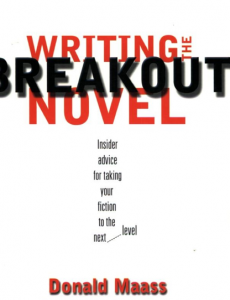 don’t know if it will work this time. A year ago, in frustration, I hired a private editor to help me figure out why the editors who were reading it weren’t drawn to my central character, when I liked her a lot. The message: I’d taken the advice from Donald Maass’s Writing the Breakout Novel–to put a character in a bad situation, make it worse, then make it worse, and then figure out how to make it worse–too literally, and failed to first make my reader care enough about my character to want to follow her through all that.
don’t know if it will work this time. A year ago, in frustration, I hired a private editor to help me figure out why the editors who were reading it weren’t drawn to my central character, when I liked her a lot. The message: I’d taken the advice from Donald Maass’s Writing the Breakout Novel–to put a character in a bad situation, make it worse, then make it worse, and then figure out how to make it worse–too literally, and failed to first make my reader care enough about my character to want to follow her through all that.
I’m halfway through this rewrite. I don’t know if it will work this time, either. But I’m embracing the new clarity, trying to bring out the character’s voice and strengths, and hoping I’ll get it right.
So, you’ve always wanted to write a book? And sometime when you have a free weekend you’re going to write one? Well…welcome to eight years of free weekends, January weeks, and everything in between. And good luck.
January 4, 2015
23 Hours and Counting
 Hello again from Sarah Graves, writing to you once more from Eastport, Maine where by the time you see this it will be mere hours until WINTER AT THE DOOR is published. That’s me at left, of course, moments after finishing the manuscript; note the pale skin, glazed eyes, and shell-shocked expression, all symptomatic of having been writing a novel for months. But now I’m all better…or no, wait a minute, I’m writing another one. So what I am, actually, is un-teachable, I guess.
Hello again from Sarah Graves, writing to you once more from Eastport, Maine where by the time you see this it will be mere hours until WINTER AT THE DOOR is published. That’s me at left, of course, moments after finishing the manuscript; note the pale skin, glazed eyes, and shell-shocked expression, all symptomatic of having been writing a novel for months. But now I’m all better…or no, wait a minute, I’m writing another one. So what I am, actually, is un-teachable, I guess. 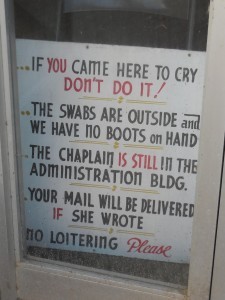
Still, I’m not crying. “Just give Sarah some pencils and she will be happy for hours” is the caption of an old B. Kliban cartoon, and it could hardly be more appropriate. I like pencils, pens, spiral notebooks, narrow-lined legal pads, typewriters, and even electronic keyboards as long as the keys aren’t sticky. My work environment is full of the things I love, no one tells me how to do it, and if I don’t like the way it’s turning out, I just delete it and do it over again (how many times I delete it and do it over is a different story, but that’s between me and my Muse.) For WINTER, I seem to recall there was quite a lot of rewrite, but that’s another thing I like about my job: the pain fades quickly.
 So here it is. I’ve shown you the cover before, but now the buy-buttons are up on sarahgraves.net and LargeFemaleWarrior.com is showing the sales ranking for pre-orders (Must. Not. Look.). That means it’s real, and not only that, it’s Out There where other people will read it, and some of them might like it but some certainly won’t, and…Must. Not. Fret. Because that pile of typed-on paper that I was so glad to see the back of as it went out the door? It isn’t mine anymore. Can’t change a word of it. Besides, while people are reading (one hopes) WINTER — the one in which ex-Boston murder cop Lizzie Snow moves to Bearkill, Maine in search of her long-lost niece, accompanied by her faithless, hot-as-a-pistol ex-lover Dylan Hudson and pursued (unbeknownst to her) by an Evil Dude — I’m writing the next book.
So here it is. I’ve shown you the cover before, but now the buy-buttons are up on sarahgraves.net and LargeFemaleWarrior.com is showing the sales ranking for pre-orders (Must. Not. Look.). That means it’s real, and not only that, it’s Out There where other people will read it, and some of them might like it but some certainly won’t, and…Must. Not. Fret. Because that pile of typed-on paper that I was so glad to see the back of as it went out the door? It isn’t mine anymore. Can’t change a word of it. Besides, while people are reading (one hopes) WINTER — the one in which ex-Boston murder cop Lizzie Snow moves to Bearkill, Maine in search of her long-lost niece, accompanied by her faithless, hot-as-a-pistol ex-lover Dylan Hudson and pursued (unbeknownst to her) by an Evil Dude — I’m writing the next book.
 So I’m feeling reasonably serene. Or as serene as I can be, anyway, when any moment anybody with a typing finger will be able to explain at length, in public and using many words of well over one syllable, just why I should’ve kept that job at Radio Shack. (Although to be fair, I’ve had some v. useful, perceptive criticism from that contingent, too.) But by then I’ll be pretty well distracted by the next book’s premise, which is: what if you were kidnapped and thrown into a cage with two other victims, and you alone escaped. You’d tell the cops, right? But — what if you didn’t? That’s the notion occupying me these days, and it’s keeping me too busy to worry about other people’s typing fingers.
So I’m feeling reasonably serene. Or as serene as I can be, anyway, when any moment anybody with a typing finger will be able to explain at length, in public and using many words of well over one syllable, just why I should’ve kept that job at Radio Shack. (Although to be fair, I’ve had some v. useful, perceptive criticism from that contingent, too.) But by then I’ll be pretty well distracted by the next book’s premise, which is: what if you were kidnapped and thrown into a cage with two other victims, and you alone escaped. You’d tell the cops, right? But — what if you didn’t? That’s the notion occupying me these days, and it’s keeping me too busy to worry about other people’s typing fingers.
 Onward, then. We here in Eastport are gearing up for a sloppy winter storm: first snow, then sleet turning to rain, following by a cold snap that promises to transform it all to glare ice for the rest of the winter. Once that happens I’ll be tottering around in boots with spikes on their soles, breathing through layers of wool to keep my lungs from freezing, and begging the dog to hurry. But up in my office there’s a heating pad to toast my feet, a laptop to keep my knees warm, and a twenty-year-old green angora cableknit sweater with vintage buttons to pull over my shoulders. Not to mention that next book’s premise, luring me slyly along…and as Lizzie Snow will be happy to tell you in WINTER AT THE DOOR, Dylan Hudson is still hot, hot, hot.
Onward, then. We here in Eastport are gearing up for a sloppy winter storm: first snow, then sleet turning to rain, following by a cold snap that promises to transform it all to glare ice for the rest of the winter. Once that happens I’ll be tottering around in boots with spikes on their soles, breathing through layers of wool to keep my lungs from freezing, and begging the dog to hurry. But up in my office there’s a heating pad to toast my feet, a laptop to keep my knees warm, and a twenty-year-old green angora cableknit sweater with vintage buttons to pull over my shoulders. Not to mention that next book’s premise, luring me slyly along…and as Lizzie Snow will be happy to tell you in WINTER AT THE DOOR, Dylan Hudson is still hot, hot, hot.
January 2, 2015
Sit. Stay. A weekend update and some writing advice for 2015 . . .
 Next week at Maine Crime Writers there will be posts by Sarah Graves (Monday), Kate Flora (Tuesday), Kathy Lynn Emerson/Kaitlyn Dunnett (Wednesday), Vicki Doudera (Thursday), and Dorothy Cannell (Friday).
Next week at Maine Crime Writers there will be posts by Sarah Graves (Monday), Kate Flora (Tuesday), Kathy Lynn Emerson/Kaitlyn Dunnett (Wednesday), Vicki Doudera (Thursday), and Dorothy Cannell (Friday).
We begin the new year with the question, posed to each of our bloggers: What is one piece of writing advice you would give to an aspiring writer whose resolution is to finally write that book?
Kate Flora: At a conference I attended recently, someone suggested that the first piece of advice to give to someone who longs to write but hasn’t yet given it a serious try is to use the words to yourself that you’d use to train your dog: Sit. Stay. That’s pretty much what my mother, who was a writer, said to me.
Barbara Ross: If I had a nickel for every time someone has said to me, “I’d write a book if I had the time,” I’d have a HUGE pile of nickels. I always look at them and think, “Do they think I have a magic machine that makes more time? I get the same 24 hours in a day as everyone else.” So here’s my advice: If you want to write, you’ll make it a priority. I know it feels selfish to steal time from job, spouse, kids, parents, but that’s what you have to do. If you don’t want to write badly enough to do that, there’s no harm in it. Don’t write and don’t stress that you’re not writing. The great thing about writing, unlike say, being an Olympic-level gymnast, or a baseball pitcher, is that you can do it at any age. Writing will be there, waiting, when you do decide to make it a priority in your life.
Susan Vaughan: The single most important thing is to write every day. But I can’t leave it at only one piece of advice. The other is to hone your craft. Learn as much as you can about what elements make a good story. Study your favorite writers and what it is that brings you back to them. And write every day. Oh, yes, I meant to repeat that.
Lea Wait: Writing advice: Read, and keep reading, especially in the genre you’re thinking of writing. And study Publisher’s Weekly. Knowing what the current market trends are won’t tell you what will be published in two or three years. But it’s a beginning. For writing advice, Donald Maass’s Writing 21st Century Fiction is on the top of my list.
Al Lamanda: My advice to aspiring writers whose resolution is to finally write that book is simple, to start it. So many young writers I talk to all seem to have the same problem, they talk about it, dream about it, research it, make notes about it, but never seem to write that first word. It’s like walking. You have to take that first step. So forget all the rules, sit down and write. Once you do get started, the words will begin to flow.
Sarah Graves: I’m of two minds about the finishing the novel advice. On the one hand, half an hour per day — the length of one TV sitcom — is not too much to ask of your own life. And you can write a novel that way. On the other, the surest way to find out whether or not you are a writer is to see whether or not you write. So I guess I’d say try it for half an hour a day, and if you keep it up you’ve got your answer, and if you don’t, then you’ve got your answer, too.
Vaughn Hardacker: Advice for an aspiring writer: Several centuries ago Confucius is supposed to have said: The longest journey starts with a single step. Likewise: The longest story starts with a single word. Write it.
Kaitlyn Dunnett: My writing advice: Don’t let anyone talk you out of making your dream a reality.
In the news department, here’s what’s happening with some of us who blog regularly at Maine Crime Writers:
From Kathy Lynn Emerson: Interested in the story behind Murder in the Queen’s Wardrobe? I answered just that question this past week at http://upcoming4.me/ Meanwhile, I’ve been putting the finishing touches on the sequel, Murder in the Mercery, so that the manuscript can be sent to my editor at Severn House next week.
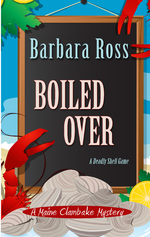 From Barbara Ross: The large print version of the second Maine Clambake Mystery Boiled Over will be released this week by Kennebec Large Print, an imprint of the fabulous Maine publisher Thorndike (a division of Cengage).
From Barbara Ross: The large print version of the second Maine Clambake Mystery Boiled Over will be released this week by Kennebec Large Print, an imprint of the fabulous Maine publisher Thorndike (a division of Cengage).
From Lea Wait: Thrilled that Shadows on a Maine Christmas was named one of the best books of 2014 by Kings River Life, a California magazine, and one of the dozen best Christmas books of the season (along with Kaitlyn Dunnett’s Ho Ho Homicide) by Library Journal.
 And excited that my Mainely Needlepoint series with Kensington Publishing will debut this week with Twisted Threads. This first in the series introduces Angie Curtis, whose mother disappeared when she was ten. Her grandmother brought her up in Haven Harbor, Maine, but she had a tough adolescence, and headed west, away from Maine, as soon as she got out of high school. Now it’s ten years later and it’s time to go home: her mother’s body has been found, and Angie is determined to find out what really happened 18 years ago, even though that will mean confronting her own past.
And excited that my Mainely Needlepoint series with Kensington Publishing will debut this week with Twisted Threads. This first in the series introduces Angie Curtis, whose mother disappeared when she was ten. Her grandmother brought her up in Haven Harbor, Maine, but she had a tough adolescence, and headed west, away from Maine, as soon as she got out of high school. Now it’s ten years later and it’s time to go home: her mother’s body has been found, and Angie is determined to find out what really happened 18 years ago, even though that will mean confronting her own past.
An invitation to readers of this blog: Do you have news relating to Maine, Crime, or Writing? We’d love to hear from you. Just comment below to share. Don’t forget that comments are entered for a chance to win our wonderful basket of books and the very special moose and lobster cookie cutters.
And a reminder: If your library, school, or organization is looking for a speaker, we are often available to talk about the writing process, research, where we get our ideas, and other mysteries of the business. Contact Kate Flora: mailto: kateflora@gmail.com
January 1, 2015
Random Thoughts On A Clean Slate
Since Beth went to stay with our younger daughter Lisa for the week between Christmas and New Years, I decided to grab a friend and spend New Years Eve at an alcathon in Waterville. For those unfamiliar with the concept, it’s an extended social gathering and meeting that sober folks put on during a holiday that can be dangerous to sobriety. Generally they happen at Thanksgiving, Christmas and New Years. It took me about five years after I got sober to avoid sliding into a dark funk just before Thanksgiving. These lasted until New Years and then I was okay again. That was because I did my level best to ruin plenty of Thanksgivings and Christmases before I was lucky enough to find AA.
Another sober friend served as DJ, playing tunes requested by some of the 81 people who came to share experience, strength and hope with other veterans of the booze battle. The food was amazing and plentiful as was the chatter and laughter. I was thrilled to see two old friends who I hadn’t seen for at least fifteen years and know they’re still in recovery. I was home and engrossed in a book by 9:30.
I’m not sure of the final reading tally for 2014, but it was around 230 books. I reviewed about 175 of them, posting copies on Amazon.com, Goodreads, the Central Maine Library Blog and Edelweis as well as sharing some of them here. Christmas replenished my ‘to be read’ stack by an additional ten from my wish list and another ten or so have arrived thanks to swaps I’ve made on Paperbackswap.com. Since most of them are young adult, with a sprinkling of new adult (perhaps the most recent sub-genre), I’m going to focus on plot similarities in 2015 and try to write up something later in the year about what trends I see in this genre and who gets it right most often. Looking back on what I read in 2014, I can say that there was a huge emphasis on grief and loss in what I read and there were plenty of love stories where the protagonist was damaged goods. In almost every instance, however, the authors were able to develop a plot that allowed readers to connect to the protagonist and become empathetic early on in the story.
2014 was extremely successful in terms of selling online. I continue to be amazed at how few libraries are willing to do this. As you know from previous columns, I get the leftovers from several other libraries after their book sales. Granted, there’s plenty of stuff that has no monetary value, but even some of that is valuable in the eyes of people who browse the free corner just inside the library door. Two types of items that most folks would consider worthless, turned out to be quite valuable and I had boxes and boxes dropped filled with both of them off late this year. Movies in VHS format and audio books on cassette are both great revenue generators if you know how to triage them. The reason for this is simple. If VHS videos never made it to DVD, and cassette books never made it to CD or downloadable audio, then the old flavors are the only game in town. Both are really easy to list on Amazon by using the UPC or ISBN. I’m listing ten examples of recently sold items below so you can see why I like getting them to sell.
1: Dead Man Walking: An Eyewitness Account $44.15 (audio cassette)
2: Escape! Because Accidents Happen: $19.40 (VHS)
3: The Wannsee Conference [VHS] $10.70
4: The Amazing Mrs. Pollifax $10.40 (audio cassette)
5: A Palm For Mrs. Pollifax $19.00 (audio cassette)
6: Michael Crichton Value Collection: $23.00 (audio cassette)
7: Frontline: A Class Divided (PBS Video) $18.90
8: Down and Out in America VHS $48.50
9: The Ape Who Guards the Balance [Audio Cassette] $28.50
10: The Golden One An Amelia Peabody Mystery [Audio Cassette] $21.70
These are considerably higher per item returns that libraries see from anything at a regular book sale. The funds generated this way are plowed back into the collection which means almost anyone in the state can benefit from the process as our items are available for borrowing through MaineCat.

Never good to let your skills get rusty.
I also sell for myself online and the excitement of the chase, to paraphrase Sherlock Holmes, is as much fun as capturing the quarry. I have a dozen or so thrift stores in a large circle surrounding Hartland that I hit when time permits. Some are pretty darn inexpensive. I went to one run by a civic organization last Monday and spent about 2 ½ hours browsing books, music CDs and DVDs. By the time I was done, I had bought $52.00 worth of stuff. Included were a couple movies I’m adding to the library collection, five music CDs that will also be added, a CD and two new board books for my granddaughter and ten or so books to swap on Paperbackswap.com. By the time I was finished listing everything that had sufficient value on Amazon.com, I had posted close to $800.00 in new inventory. Granted not all of it will sell, but it won’t take very long to recoup my investment and the rest will be profit. Even so, the challenge of looking through a shelf of books and letting experience and gut feeling determine which to buy is one heck of a lot of fun and because I know it’s easy to make my investment back pretty much every time I do this, there’s no irrational guilt about wasting money. I’m looking forward to hitting more library book sales once I retire in June.
Speaking of retirement, that’s going to be the biggest adjustment/challenge in 2015. Weekends have taught me that thinking I have large blocks of time in which to do amazing amounts of work is pretty much a delusion. I’m too easily distracted and every book in the house has learned to talk. They whisper as I walk by, promising me endless exotic journeys that have light years more appeal than vacuuming, lawn mowing or taking scraps to the compost. When I grab a bag of pellets from the storage building, my metal detector invariably starts crying and telling me I must not love it or I’d spend more time running it over the back yard or the old fairgrounds. I’ve tried pointing out that the ground is rock hard, but that argument goes nowhere. Fortunately, I’m past the mental battle about what will be left for image and self-esteem once I relinquish my role as Hartland Librarian. Since I’m tentatively committing one day a week to catalog for other libraries, my favorite skill isn’t in danger of being lost.

This fellow likes the west branch of the Sebasticook River in Hartland.
Now that my brain is coming around again, I have several things I hope to work on as a writer in 2015. I’m challenging myself to enter at least six short stories in various competitions. Over and above that, I’m hoping to go back and finish Finding Ginger, as well s start on Shear Pin Summer (a juvenile mystery) and another YA teen romance with a bit of urban fantasy. It starts in Washington County with one generation, opens 20 years later in Los Angeles and moves back to Washington County where it will involve secrets, blueberries and what I hope will be a dandy teen romance. Stay tuned to see how all this unfolds.
I hope you had as great a Christmas and New Years as I did. I’m loving the grandfather gig and having Piper enjoy her first Christmas at our house made it the best one ever.

I am sooo Cool!
Lea Wait's Blog
- Lea Wait's profile
- 509 followers





